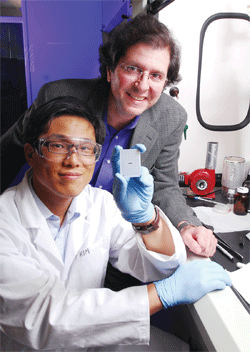Encapsulation technique exploits high-dielectric barium titanate to construct ceramic/polymeric caps
A novel encapsulation technique will enable the coveted high-dielectric properties of barium titanate (BaTiO3 ) nanoparticles to be exploited for fabricating capacitors, according to researchers at Georgia Institute of Technology’s Center for Organic Photonics and Electronics in Atlanta. The technique could allow capacitors to store up to twice as much energy as existing devices.

Scanning electron micrographs of barium titanate nanocomposites with polycarbonate (top and bottom left) and Viton (top and bottom right) polymer matrices show a dramatic improvement in film uniformity.
Materials scientists have long been interested in BaTiO3 for use in capacitors, but good dispersion of the material within a polymer matrix has continually been a problem. The new process uses tailored organic phosphonic acids to encapsulate and modify the surface of the nanoparticles to overcome those problems and create uniform nanocomposites. The result is what Perry calls a hybrid capacitor: part polymeric, and part ceramic.
“Our team has developed nanocomposites that have a remarkable combination of high dielectric constant and high dielectric breakdown strength,” said Joseph W. Perry, a professor in the Georgia Tech School of Chemistry and Biochemistry and the Center for Organic Photonics and Electronics. “For capacitors and related applications, the amount of energy you can store in a material is related to those two factors.”
The materials have been tested up to 1 MHz, which means that for now, capacitors produced with this construction would most suit pulse-power-type applications, where a quick burst of energy is needed. “We’re talking about a microsecond time scale,” Perry said. “I’d like to go down to nanoseconds.”
Getting into applications like cell phones, however, will require operation at much higher frequencies. “We want to be up in the gigahertz range,” Perry said. But there are obstacles. “The general trend is, as you go to higher frequencies, there tend to be some rolloffs. We want to know what are the rolloff frequencies for these materials and how big will the rolloffs be.”
Since the technique was first reported in the April 2007 edition of Advanced Materials , Perry said about four or five component manufacturers have already shown interest. “We did not expect to get the kind of surge of interest this work has generated,” Perry said. The technology is currently available in the form of licenses, and there is hope that some companies will choose to financially support further research and development.

Georgia Tech researchers Joe Perry and Philseok Kim display a capacitor array device made with a barium titanate nanocomposite.
Though the new materials could have commercial application without further improvement, their most important contribution may be in demonstrating the new encapsulation technique—which could have broad applications in other nanocomposite materials. “Beyond capacitors, there are many areas where high dielectric materials are important, such as field-effect transistors, displays, and other electronic devices,” Perry said. “With our material, we can provide a high dielectric layer that can be incorporated into those types of applications.”
For more information, call Perry at 404-385-6046, e-mail joe.perry@gatech.edu, or visit http://gtresearchnews.gatech.edu/newsrelease/barium-titanate.htm.
Ralph Raiola
Advertisement
Learn more about Georgia Institute of Technolog





